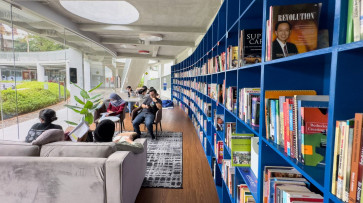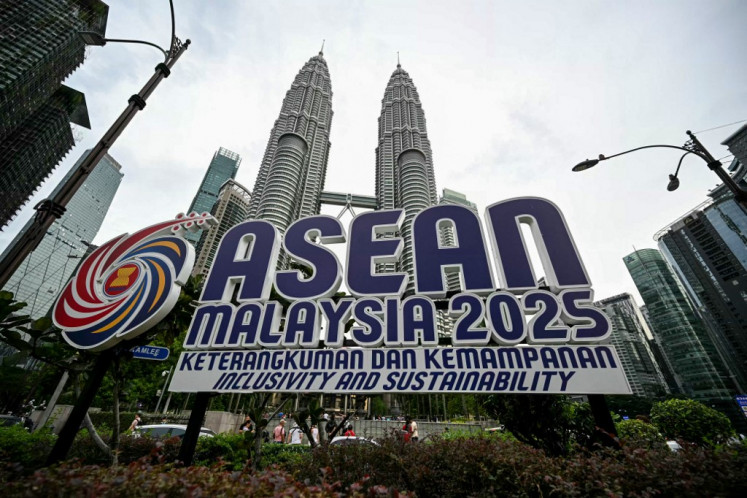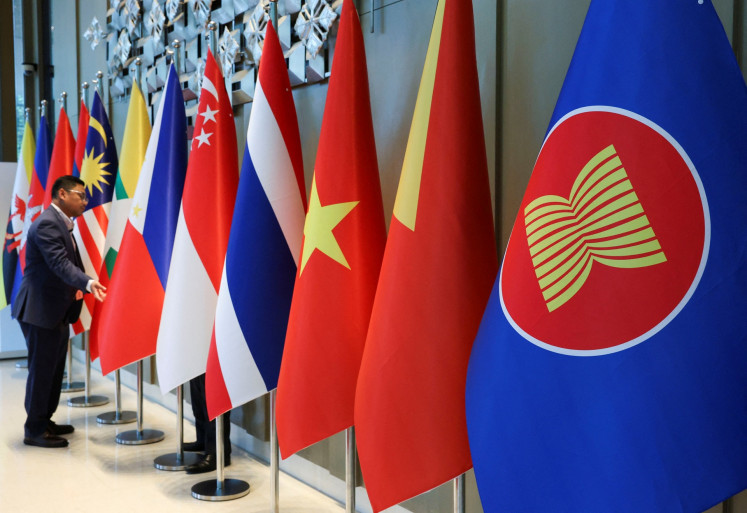‘Living as Clay’: Danish artists reimagine terracotta city in Jatiwangi
Collaboration: Danish artist Emil Krog Rasmussen and students work on Connecting Clay, a public sculpture made of interconnected clay chains, at Al-Mizan Islamic boarding school in Jatiwangi, West Java
Change text size
Gift Premium Articles
to Anyone

C
ollaboration: Danish artist Emil Krog Rasmussen and students work on Connecting Clay, a public sculpture made of interconnected clay chains, at Al-Mizan Islamic boarding school in Jatiwangi, West Java.
Copenhagen-based Amalie Frederiksen returned to the Jatiwangi Art Factory (JaF) in Majalengka regency, West Java, in October this year after having visited the town twice before.
Founded in 2005, JaF is a nonprofit organization focusing on the study of rural life through art and it is used to working with European artists.
JaF plays a pivotal role in developing a new visual vocabulary, which will be applied to transforming Jatiwangi — the historic terracotta city with a precarious clay industry — into a 21st century player.
In the art factory, the 35-year-old independent art curator and founder of Another Public art agency, Frederiksen, joined in the creative synergy to explore clay as a social art medium.
She brought with her three Danish artists — Jesper Aabille, Emil Krog Rasmussen and Christian Elovara Dinesen – each with abundant experiences in site-specific public art projects.
For their projects at the fifth Indonesia Contemporary Ceramics Biennale, held from June to October this year, the three artists’ works focused on one theme: “Living as Clay”.

Each was assigned a public institution in Jatiwangi: Aabille traded fruit and vegetables with painted tiles at a traditional market; Rasmussen collaborated on a public sculpture with students at an Islamic boarding school; and Dinesen made clay fruit for a nutrition awareness campaign at the local health center.
For Aabille, it was an easy start. “The owner of Pasar Ciborelang shouted out the rules through a microphone to the crowd at the market and off I went. If people wanted a particular kind of fruit painted on a tile, they could ‘buy’ the tile with the real fruit. Surprisingly, I was quickly accepted as a fellow trader in the market and all the other traders were fascinated with this new currency: painted roof tiles,” he says.
People swarmed in with a variety of products and each taught Aabille how to serve them. Someone came with two bags of fried grasshoppers and Aabille tried them too. “There were cauliflowers, stinky beans, pineapples and I learned how to cut a mango.”
“I was asking my customers nonverbally why they were willing to trade real products for my tiles. I wanted them to think about how new value can be projected onto a familiar material,” reflected Aabille.

Rasmussen became a selfie target at Al-Mizan Islamic boarding school. “Then we worked hard from Monday to Wednesday for three weeks, three hours each day. Over a hundred students participated and each made either interlinked chains or individual chains that could later be tied together; then we fired the clay and made a long chain to install on trees in the schoolyard.”
The young students’ creativity and concentration impressed Rasmussen.
“It is the process that mattered: We all made a mini-sculpture with the same material and were forced to communicate. Javanese people tend to be polite and rarely quarrel, so I think there must be some ways to resolve the social tensions. In a consumer society, peer pressure from social media drives people to buy their identity rather than perform their identity. We were there to perform.”
Dinesen quickly polished his karaoke skills with the staff at the Jatiwangi community health center (Puskesmas). “First, Christian did a questionnaire survey asking children what they think is ‘superfood’ and then he made fruit models based on the answers, which were later used at a nutrition awareness campaign,” explained Frederiksen. They were so vivid that one kid tried to take a bite of a clay avocado.

Dinesen found it quite difficult “flipping back” to life in Copenhagen. “Coming home is hard. [In Jatiwangi] they have a society that is far more kind, far more social, and even though they face much bigger problems than I do in everyday life, they live a far more joyful life […] I miss the constant selfies, which is the opposite of me.”
Rasmussen said he loved the way people in Jatiwangi used materials to claim territory. “People fill small plastic baskets with cement, then put a bamboo stick in it, and this makes a perfect mobile signpost,” he says.
“And it is through shaping your surroundings that you find your own identity and that keeps the terracotta city from disappearing,” said Frederiksen.
“Jatiwangi won’t assume the socioeconomic core in West Java it once had with a fading identity,” added Aabille.
Frederiksen said they were there as lenses — the projects offered residents of Jatiwangi new perspectives on their given medium.
She said she was not quite ready for her 24-hour flight back to Copenhagen. “I know 30 minutes after I get home, I will start to miss Jatiwangi: the heat, the friendly people, the social spontaneity.” (ste)

— Photos courtesy of Pandu Ramadan









